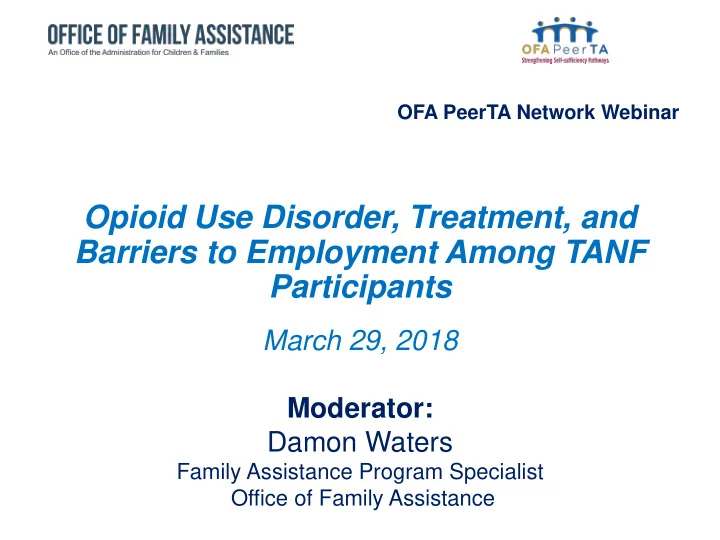

OFA PeerTA Network Webinar Opioid Use Disorder, Treatment, and Barriers to Employment Among TANF Participants March 29, 2018 Moderator: Damon Waters Family Assistance Program Specialist Office of Family Assistance
Use the Q & A in the lower left corner of your screen to submit questions to the presenters. To ask a question, simply type into the text box as seen below and then press enter.
Please remember to provide your feedback on this Webinar using the survey that will appear in a separate pop-up window when the Webinar ends.
OFA PeerTA Network Webinar • Overview Justin Germain, MEF Associates • Kentucky’s Targeted Assessment Program Barbara Ramlow, University of Kentucky Center on Drug & Alcohol Research • Vermont’s CHARM (Children and Recovering Mothers) Team Ann M. Johnston, University of Vermont Children’s Hospital Sally Borden, KidSafe Collaborative • Facilitated Q&A, Damon Waters, OFA
Audience Poll #1 To what extent is opioid use disorder a problem among clients in your TANF program? a. Not at all b. Somewhat of a problem c. A large problem d. Unsure
OFA PeerTA Network Webinar Overview Justin Germain MEF Associates
Opioid Use Disorder, Treatment, and Barriers to Employment Among TANF Participants Justin Germain March 29, 2018
Roadmap Prevalence of Opioid Use Disorder (OUD) Prevalence Among TANF and Low-Income Populations Effects on Employment Treatment and Prevention Strategies OUD Specific Populations Challenges Conclusion 8
Source: Council on Foreign Relations; National Institute on Drug Abuse; Centers for Disease Control and Prevention 9
10 Source: Centers for Disease Control and Prevention; Business Insider
OUD Prevalence in TANF and Low-Income Populations Research on TANF and TANF-eligible families focuses on general substance use disorders OUD rates among Medicaid recipients can help draw parallels to TANF recipients Screening and assessment procedures may underestimate the scope of OUD among individuals receiving public assistance 11
Effects on Employment OUD falls within a web of coexisting barriers to employment Employment before or during treatment may increase employment retention and success Higher county unemployment rates correlate to higher opioid-related death rates Employment alone may not be enough to stem OUD 12
Treatment and Prevention Strategies: OUD Medication-assisted treatment (MAT) Medication Methadone Buprenorphine Naltrexone Counseling 13
Treatment and Prevention Strategies: OUD Strategies Curbing Improper Prescribing Practices National Prescribing Guidelines Prescription Drug Monitoring Programs Pill Mill Laws Contingency Management Community Prevention Coalitions 14 Source: Centers for Disease Control and Prevention
Treatment and Prevention Strategies: Specific Populations TANF Participants and Women with Dependent Children Screening and Assessment Intensive Case Management Individualized Placement and Support Model of Supported Employment Family-Centered Treatment 15
Treatment and Prevention Strategies: Specific Populations Child Welfare Families Family Treatment Drug Courts Recovery Coaches and Counseling 16
Challenges There is limited information about opioid treatment strategies targeted at employment for TANF participants Coexisting barriers may hinder the accessibility of treatment Limited collaboration across social service systems can hinder screening and treatment OUD harms individuals throughout the entire workforce system Individuals at risk of losing public assistance or custody of their children fear disclosing their OUD 17
Conclusion Key Takeaways There is limited research about the opioid crisis among TANF participants OUD is one of many coexisting problems that worsen difficulties in securing employment Implications for Future Research There is a need for more research on the prevalence of OUD among the TANF and TANF-eligible populations Certain treatment strategies have been shown to be effective and could be evaluated for TANF 18
Contact Information Justin Germain MEF Associates justin.germain@mefassociates.com (703) 838-2727
Audience Poll #2 How do you screen and assess your clients for substance use disorders? a. Do not screen b. Self-disclose on application c. Assessment tool d. Mandatory drug test e. Other
OFA PeerTA Network Webinar Kentucky’s Targeted Assessment Program Barbara Ramlow University of Kentucky Center on Drug & Alcohol Research
Recommend
More recommend